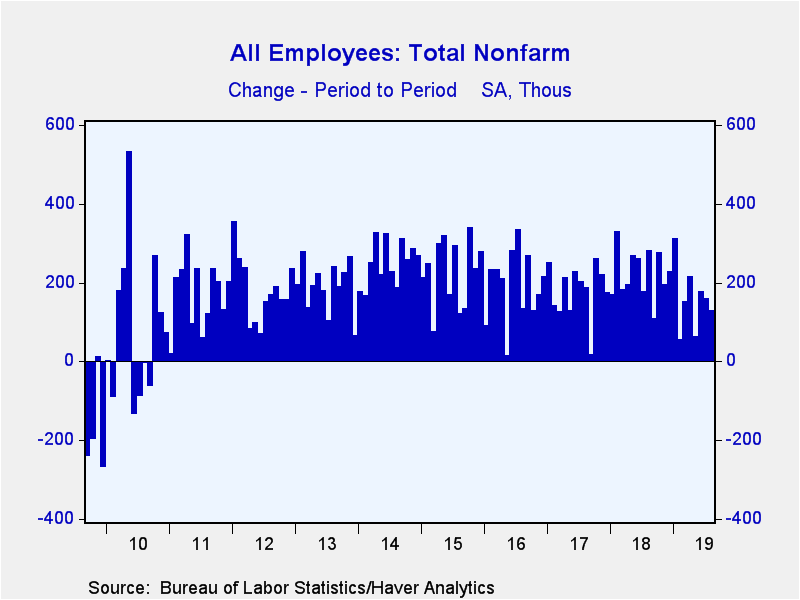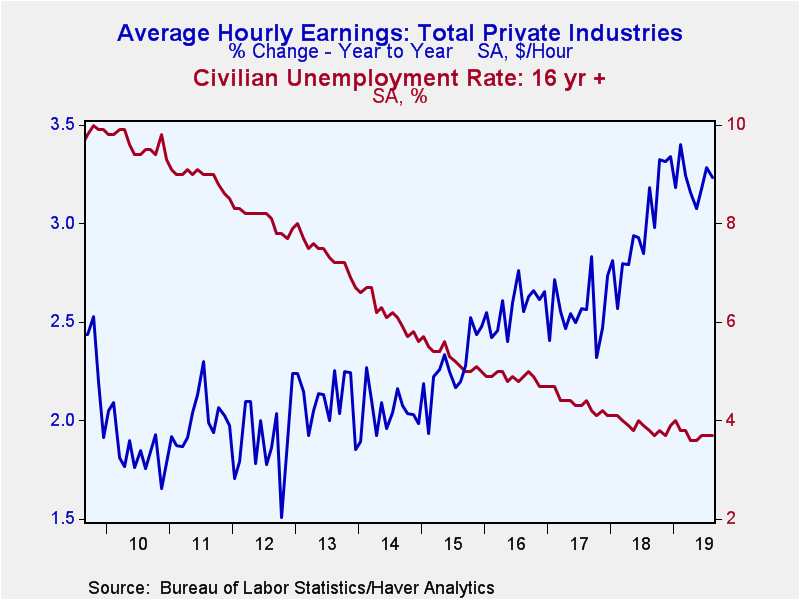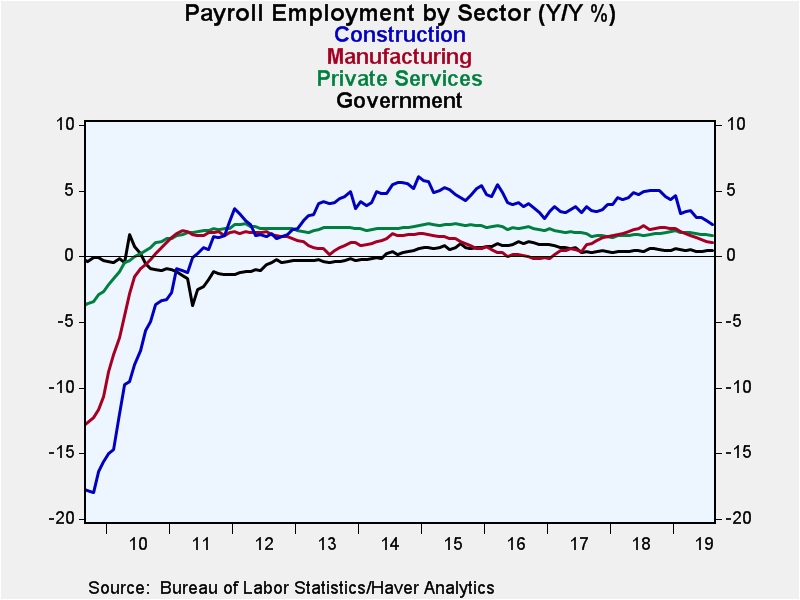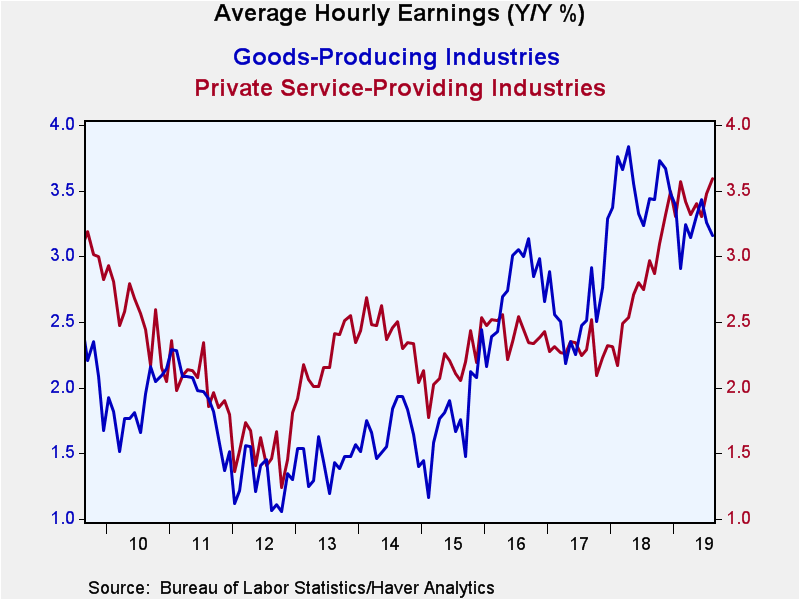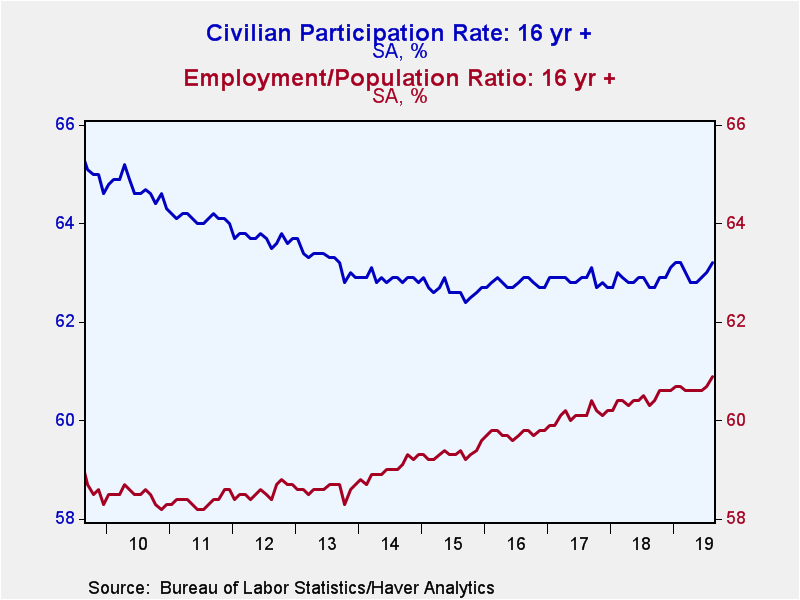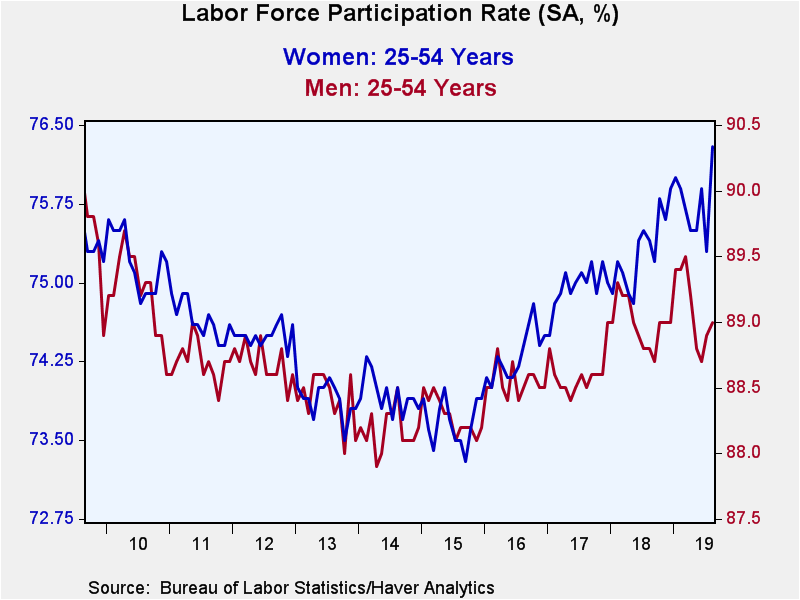 Global| Sep 06 2019
Global| Sep 06 2019U.S. Payroll Increase Disappoints; Earnings Strengthen While Jobless Rate Holds Steady
by:Tom Moeller
|in:Economy in Brief
Summary
Job growth continues to decelerate. Nonfarm payrolls increased 130,000 (1.4% y/y) during August following a 159,000 July rise, revised from 164,000. June's increase also was revised lower to 178,000 from 193,000. A 163,000 August [...]
Job growth continues to decelerate. Nonfarm payrolls increased 130,000 (1.4% y/y) during August following a 159,000 July rise, revised from 164,000. June's increase also was revised lower to 178,000 from 193,000. A 163,000 August increase had been expected in the Action Economics Forecast Survey. So far this year, payrolls have risen an average 158,000 per month after a 223,000 monthly average last year. Average hourly earnings in the private sector increased 0.4% following three consecutive months of 0.3% gain. A 0.3% increase had been expected. Growth during the last twelve months of 3.2% remained below the recent peak of 3.4% logged in February.
The unemployment rate held steady at an expected 3.7%. Employment in the household survey rose 590,000 (1.5% y/y) and the labor force increased 571,000 (1.3% y/y). The overall jobless rate, including those who were marginally attached or working part-time for economic reasons, rose to 7.2% from 7.0% in July, reversing that month's decline.
From the payroll employment survey, the lessened 130,000 job increase reflected a weakened 3,000 gain (1.0% y/y) in factory sector jobs after a 4,000 July rise. Construction sector employment improved 14,000 (2.3% y/y) following a 2,000 easing. Employment in the mining & logging area, where job growth has been weakening since the middle of last year, hiring declined 5,000 (+0.7% y/y), down for the third consecutive month.
Jobs in the private service sector rose 84,000 (1.5% y/y), the smallest increase in three months. Weakness was scattered throughout the sector. Trade, transportation & utilities employment declined 11,000 (+0.3% y/y) with retail jobs decreasing 11,100 (-0.6% y/y). Nonstore retail jobs eased 1,700 (-0.3% y/y), off for the fourth month in the last five. Education & health care jobs rose 32,000 (2.5% y/y), the weakest increase in six months, reflecting a 5,400 decline (+1.3% y/y) in educational services. Information services employment held steady (0.2% y/y) for the second straight month. Offsetting these weaknesses, the number of professional & business services jobs rose a steady 37,000 (2.1% y/y). Temporary help employment jumped 15,400 (0.6% y/y), reversing three consecutive months of decline. Financial services jobs rose 15,000 (1.3% y/y), triple the gains early in the year.
Government sector employment rose an improved 34,000. The 0.6% y/y rise left it down from its 0.9% gain one year earlier. Federal government jobs surged 28,000 (1.8% y/y) which mostly reflected a jump in Census workers. State government employment rose 6,000 but was unchanged y/y. The number of local area government jobs was unchanged (0.5% y/y) following a 14,000 rise.
Average hourly earning increased a strengthened 0.4%, but the 3.2% y/y increase remained in line with the y/y gains of the last twelve months. Construction sector earnings rose 0.4% m/m and a depressed 2.7% y/y. Factory sector pay rose 0.3%. The 2.7% y/y increase was firmer than the 1.3% y/y gain as of July last year. Private service sector earnings rose 0.4% (3.3% y/y). Financial services sector earnings strengthened 0.9% (4.0% y/y) and information sector pay jumped 0.8% (5.8% y/y). Leisure & hospitality earnings rose a steady 0.2% (3.6% y/y) while education & health services sector pay gained 0.1% (1.7% y/y).
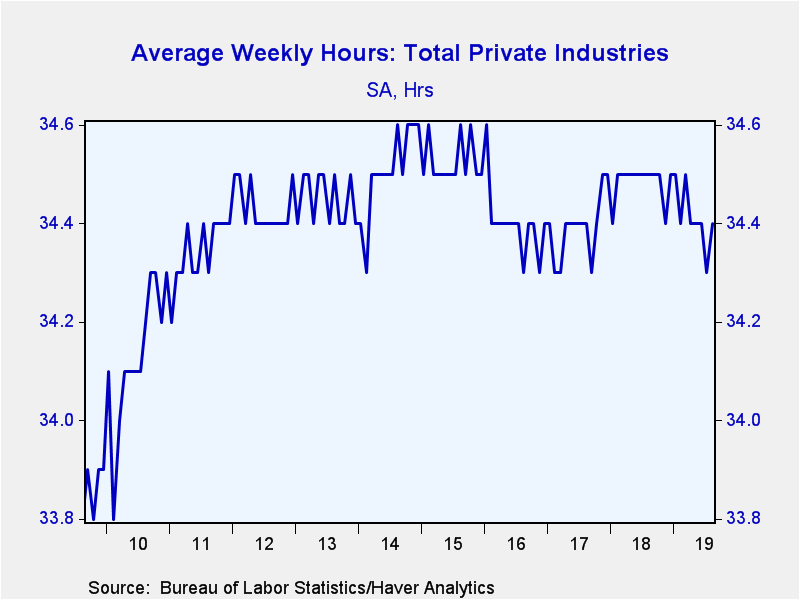 The average number of hours worked per week rose to 34.4 and
reversed July's decline. Mining & logging sector hours held steady at an
elevated 46.3. Factory sector hours rose to 40.6 but remained below the recovery
peak of 41.0. Construction sector hours jumped to 39.4, the most in five months.
Private service sector hours worked improved to 33.3 reflecting a rise in
financial sector hours to 37.7, the most in five months. Professional &
business services hours surged to 36.3, and equaled the record high. Information
sector hours rose moderately to 36.3 while education & health hours held
steady at 33.0. The length of the average workweek in the leisure &
hospitality sector was little changed at 25.9, but remained below the 2015 high of 26.3.
The average number of hours worked per week rose to 34.4 and
reversed July's decline. Mining & logging sector hours held steady at an
elevated 46.3. Factory sector hours rose to 40.6 but remained below the recovery
peak of 41.0. Construction sector hours jumped to 39.4, the most in five months.
Private service sector hours worked improved to 33.3 reflecting a rise in
financial sector hours to 37.7, the most in five months. Professional &
business services hours surged to 36.3, and equaled the record high. Information
sector hours rose moderately to 36.3 while education & health hours held
steady at 33.0. The length of the average workweek in the leisure &
hospitality sector was little changed at 25.9, but remained below the 2015 high of 26.3.
From the household employment survey, the unchanged 3.7% unemployment rate and the gain the labor force reflected a rise in the labor force participation rate to 63.2%. That was up from the September 2015 low of 62.4%. The teenage participation rate eased to 35.5% and for those aged 20-24, it fell to 71.9%. For workers aged 25-54, the rate increased to a cycle high of 82.6%. For men in that age bracket the rate rose to 89.0% and for women of that age it increased to 76.3%. For workers aged 55 & over, the rate eased to 40.3%, but still was increased from 30% in 1995.
The teenage unemployment rate declined to 12.6% and the rate for workers age 20-24, it rose slightly to 7.0%. For workers age 25-54, the rate held steady at 3.1%. For those over 55, the jobless rate eased to 2.6%.
By education attainment, workers without a high school diploma were 5.4% unemployed. High school graduates without a college degree were 3.6% unemployed and those with some college but no degree were 3.1% without work. College graduates experienced 2.1% unemployment.
The labor market data are contained in Haver's USECON database. Detailed figures are in the EMPL and LABOR databases. The expectations figures are in the AS1REPNA database.
| Employment: (SA, M/M Change, 000s) | Aug | Jul | Jun | Aug Y/Y | 2018 | 2017 | 2016ss |
|---|---|---|---|---|---|---|---|
| Payroll Employment | 130 | 159 | 178 | 1.4% | 1.7% | 1.6% | 1.8% |
| Previous Estimate | -- | 164 | 193 | -- | -- | -- | -- |
| Manufacturing | 3 | 4 | 10 | 1.0 | 2.0 | 0.7 | 0.1 |
| Construction | 14 | -2 | 19 | 2.3 | 4.6 | 3.6 | 4.1 |
| Private Service-Producing | 84 | 133 | 134 | 1.5 | 1.7 | 1.8 | 2.2 |
| Government | 34 | 28 | 17 | 0.6 | 0.4 | 0.6 | 0.9 |
| Average Weekly Hours - Private Sector | 34.4 | 34.3 | 34.4 | 34.5 | 34.5 | 34.4 | 34.4 |
| Private Sector Average Hourly Earnings (%) | 0.4 | 0.3 | 0.3 | 3.2 | 3.0 | 2.6 | 2.6 |
| Unemployment Rate (%) | 3.7 | 3.7 | 3.7 | 3.8 | 3.9 | 4.4 | 4.9 |
Tom Moeller
AuthorMore in Author Profile »Prior to joining Haver Analytics in 2000, Mr. Moeller worked as the Economist at Chancellor Capital Management from 1985 to 1999. There, he developed comprehensive economic forecasts and interpreted economic data for equity and fixed income portfolio managers. Also at Chancellor, Mr. Moeller worked as an equity analyst and was responsible for researching and rating companies in the economically sensitive automobile and housing industries for investment in Chancellor’s equity portfolio. Prior to joining Chancellor, Mr. Moeller was an Economist at Citibank from 1979 to 1984. He also analyzed pricing behavior in the metals industry for the Council on Wage and Price Stability in Washington, D.C. In 1999, Mr. Moeller received the award for most accurate forecast from the Forecasters' Club of New York. From 1990 to 1992 he was President of the New York Association for Business Economists. Mr. Moeller earned an M.B.A. in Finance from Fordham University, where he graduated in 1987. He holds a Bachelor of Arts in Economics from George Washington University.


